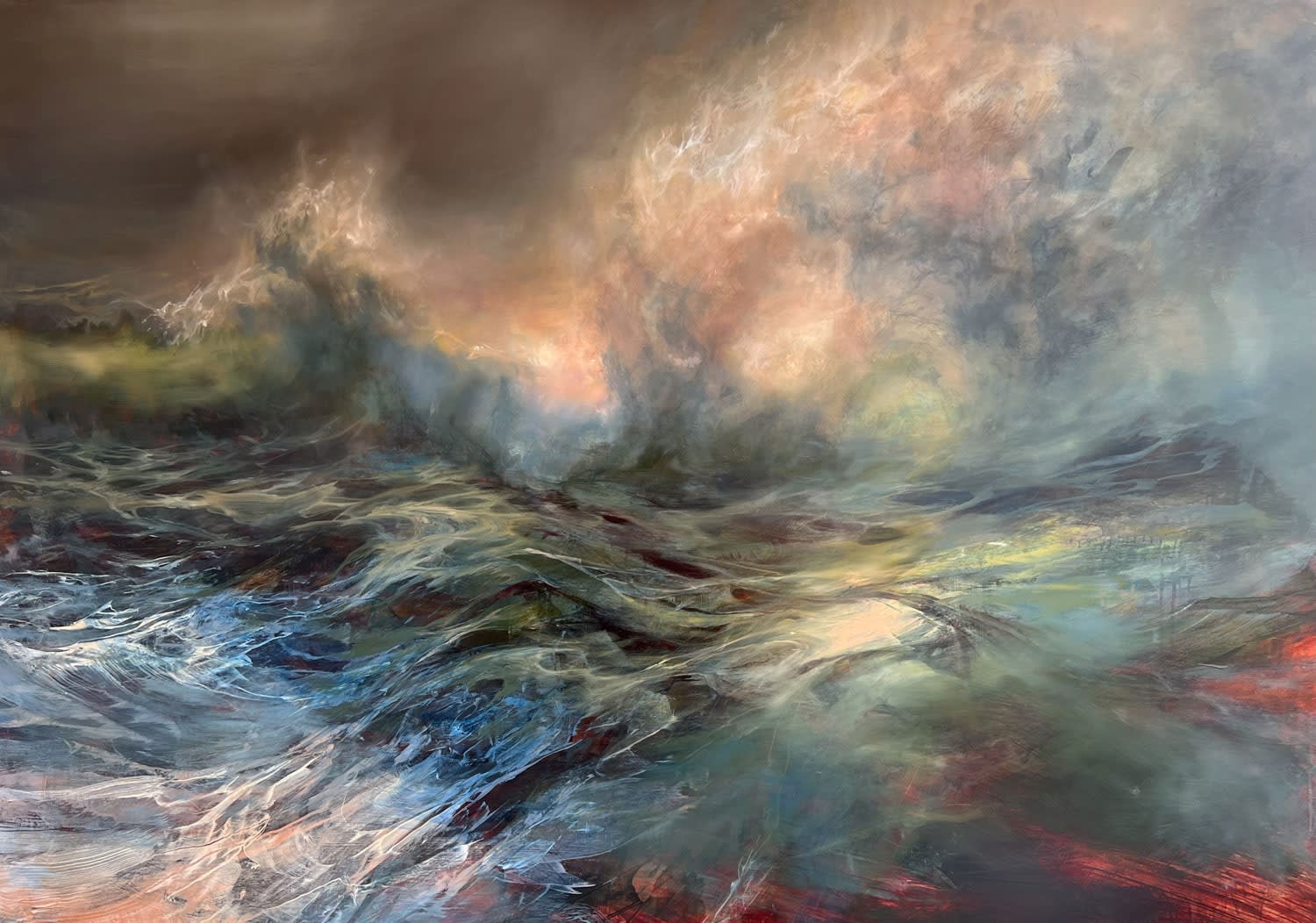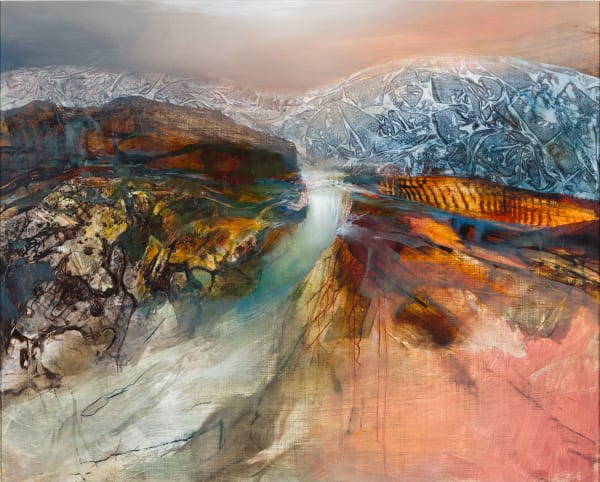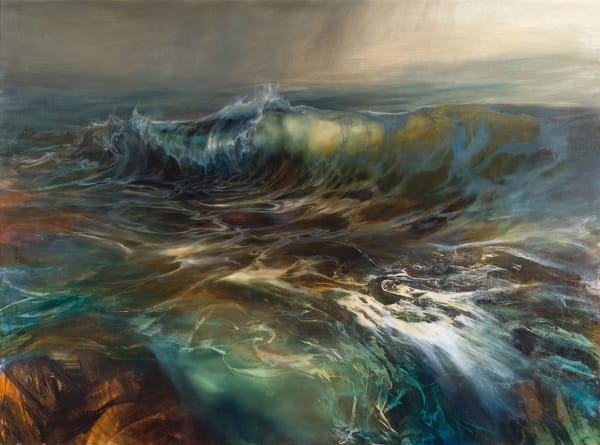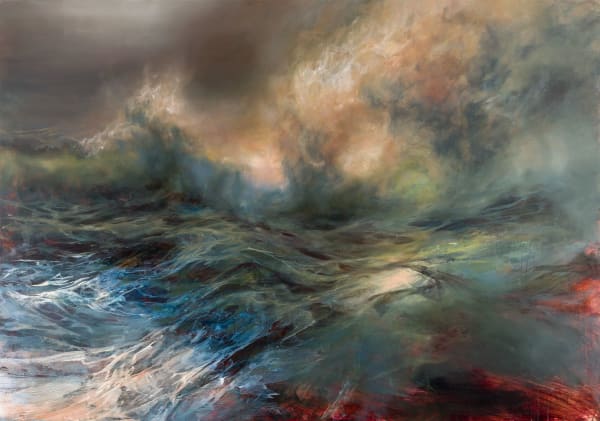-
 Beth Robertson Fiddes - Water and Light (mixed media)
Beth Robertson Fiddes - Water and Light (mixed media) -
In Conversation- Beth Robertson Fiddes | Water and Light
On the eve of her latest solo exhibition at Kilmorack Gallery, Beth Robertson Fiddes spoke to Georgina Coburn about the forces at work in her latest series of mixed media paintings, inspired by land and sea.GC: Your latest solo exhibition Water and Light draws on your experience of the Northwest and the Isle of Lewis. Can you tell us about your time in the field leading into this series of paintings? What were some of the discoveries?
BRF: I’ve been spending a lot of time at the coast near home and also had the opportuntity to revisit the northwest coast of Lewis. It’s important just to go and see what happens. I’ve learned over time that making too many plans to find or see particular things means there a chance I’d miss what’s actually worth seeing. I’ve discovered new pools in places close to home that I must have passed a hundred times. Treasures hidden only by my haste to reach a specific destination in the past.
I’d been to Ness before, and my intention was to return to see some hopefully wild water but I decided to explore the rocks around Eoropie at the last minute. It was quite something. Perfect light coming from the west, low in the sky, huge breakers without too much wind. I will return as I feel there is so much more to see there.
GC: Last Snow achieves a palpable, fluid sense of time, from the monumental, layered patterns of ice and snow in the background to the sublime, gestural brushwork of the foreground. There’s an ethereal quality, almost a dream state, communicated in the convergence of realism and abstraction, a shimmering path at the centre of the composition. How has your direct experience of land and seascape pushed the boundaries of your paint handling in this latest body of work?
BRF: Last Snow is based on walks further inland. Not based on any particular day but a collection of memories over the years. There’s a time every year where signs of winter are still everywhere but a change in the air lets you know the snow days have passed and spring is near. It’s not a fixed date on the calendar and it doesn’t necessarily coincide with any festival or celebration. This painting is a visual note of that time. Not a dramatic scene but an important moment to be marked.
In this painting and in others in this collection, the layers of paint are applied in different ways, brush, rags, paper, and wash, often elements are removed by sanding, scraping back or over painting either completely or partially with a wash of semi opaque paint. These ways of handling materials mirror the way I collect memories of individual visual elements, the shimmering path, the familiar patterns made by thawing snow, the dark silhouettes emerging from frozen ground. These memories are stashed away ready for future use but some are lost, overshadowed and set aside for a different piece. I have to make choices about which elements I want to bring to the surface each time. I could maybe paint the same location several times with the emphasis changing in each piece. It’s important to me to edit the contents of the painting. The original idea is not always the focus of the final work.
GC: One of the largest paintings in the show, Water and Light, is a very powerful melding of natural forces and painterly elements. Can you describe the energies at work in this painting and how you felt bringing them together in such a beautifully balanced and unbridled way?
BRF: Sometimes, very rarely, it feels that everything has just been waiting for me to arrive. This painting is based on the tides at Eoropaidh. The conditions were everything I could hope for. Perfect low light. Huge swell and waves crashing almost over my head. The lack of wind made the water almost hover in the air as it dispersed over the rocks, creating arches and curls and a real sense of structure albeit a very temporary one. I always think of these kinds of waves as “Cathedral Waves”. They create a sense of space and awe even if only for the blink of an eye. It’s a rare thing to have everything line up this way. In creating Water and Light I had to battle to keep the sense of space which was my initial point of interest balanced with the sense of power in the crashing wave. Either one could have been lost to the other.
GC: There is an intense, tactile quality in Limestone i and ii, with the extraordinary texture of stone framing an inner body of water. This combination, of sheer physicality and deep contemplation, heightens the viewer’s sense of a living, imaginative ground, a multi-layered landscape steeped in lore and memory. How would you describe the depth and stillness at the heart of these works, and do you see your work as part of a wider Northern tradition?
BRF: I seek out little oases of calm and still water everywhere I go. These ones at Balnakeil seem particularly protected from the elements. These rock formations appear soft with their bubbly puff candy texture and gentle curves. In reality they are solid, rough and difficult to scramble over without scratches and scrapes. They almost cup the pools in their hands, fending off the world, saving them from the wind and tides and me. They do invoke a sense of sanctuary but also questions. What might they hide in their kelpy depths? There is also a feeling of uncertainty even here. I don’t consciously try to create work which relates to a wider Northern tradition but I’m sure it has parallels.
GC: In Autumn Tides and Breaking Wave, Lewis, you capture moments of extreme turbulence and profound clarity in the light shining through water. It is more than being mesmerised by the sea or being held in that movement, it reaches for something beyond what we can see with our eyes. Can you describe what draws you to those thinly veiled spaces and why it is important to reach for them in your practice?
BRF: In these works, I have tried to create a balance of contrasts. The water catches the light. You wouldn’t see the light in exactly that place if the water wasn’t holding it. The water is both a barrier between the viewer and the light and a way of bringing that light forward, creating other focal points in the piece. I’m always looking for situations where this is happening or might happen. Places which allow me to experience the power and threat the sea holds while also offering illuminated windows of light and optimism. Places where this can happen are treasures to me.
GC: Your work has been described as ‘magical’, ‘cinematic’ and ‘awe-inspiring.’ How does storytelling, as part of the creative process, inform your work and how have different creative disciplines shaped your understanding of land and seascape?
BRF: I love films. As a child they were a rare and treasured thing, something to be focused on, absorbed, and considered and remembered. There is no doubt that they have had an effect on my work. I’m sure I draw on their influence when attempting to create a sense of space and drama visually. Often I think both film and music influence my choice of titles for work. Sometimes parallels and connections occur to me when I’m out and about and sometimes when working through things in the studio. These thoughts can create new stories in the paintings and take them off in new directions. Music is very important to me when working in the studio. It helps create a bubble I can work in, and I often listen to the same music for a particular group of works. I find the patterns in the music help my focus and they also connect to the kinds of rhythms found in water and rock. I’ve been listening to a lot of Philip Glass and various film and TV scores while working on this body of work.
GC: As a solo exhibition, Water and Light brings a different level of awareness into play in terms of painterly craft and appreciation of landscape. How would you describe your relationship to place and how has it evolved through this latest body of work? What do you hope audiences will take away from the experience?
BRF: I think this collection of work is a continuation of my relationship with this corner of Northwest Scotland with water, wind and light taking over the reins. I feel these works are a result of simply being in a place and experiencing everything that has to offer rather than a quest to find particular set of circumstances. They are more a result of wanderings in special places. Where there are no dramatic tides and perfect light I can find quiet backwaters and kelp filled rockpools with hidden depths and reflections containing all sorts of mysteries. I hope that visitors to the exhibition take away even just a few of the same feelings of power, tranquillity, beauty and awe that I experience in my wanderings of the Northwest coast.
-
In Conversation - Beth Robertson Fiddes 'Water and Light': Q&A with Beth Robertson Fiddes and Georgina Coburn
Past viewing_room






